
- Home
- India
- World
- Premium
- THE FEDERAL SPECIAL
- Analysis
- States
- Perspective
- Videos
- Sports
- Education
- Entertainment
- Elections
- Features
- Health
- Business
- Series
- In memoriam: Sheikh Mujibur Rahman
- Bishnoi's Men
- NEET TANGLE
- Economy Series
- Earth Day
- Kashmir’s Frozen Turbulence
- India@75
- The legend of Ramjanmabhoomi
- Liberalisation@30
- How to tame a dragon
- Celebrating biodiversity
- Farm Matters
- 50 days of solitude
- Bringing Migrants Home
- Budget 2020
- Jharkhand Votes
- The Federal Investigates
- The Federal Impact
- Vanishing Sand
- Gandhi @ 150
- Andhra Today
- Field report
- Operation Gulmarg
- Pandemic @1 Mn in India
- The Federal Year-End
- The Zero Year
- Science
- Brand studio
- Newsletter
- Elections 2024
- Events
In Photos | How Raichur is preparing the fields for FarmHers

The sun beats down on Radhamma’s back as she moves through the rows of chilli plants, swiftly plucking the ripe, red peppers in Raichur’s Devadurga village. A tattered scarf is tied tightly around her head but it offers little respite from the dry winter heat. Fields of byadgi chilli are ready for harvest, and the women of Raichur district in Karnataka have little time to straighten...
The sun beats down on Radhamma’s back as she moves through the rows of chilli plants, swiftly plucking the ripe, red peppers in Raichur’s Devadurga village. A tattered scarf is tied tightly around her head but it offers little respite from the dry winter heat. Fields of byadgi chilli are ready for harvest, and the women of Raichur district in Karnataka have little time to straighten their backs.
“The burning never stops,” says Radhamma as she straightens her back to rest. She holds out her hands—her skin is raw and tinged red from the frequent exposure to capsaicin. “Even after washing them tens of times, we still feel the fire,” she says. Anuradha chimes in, “We even rub coconut oil on our palms before washing them but it doesn’t help.”
Chilli cultivation in Raichur has seen an increase in the past few years. The kharif crop flowers twice in one season, making it a lucrative option for farmers, especially in semi-arid regions like northern Karnataka. However, there has been no technological advancement to ease the drudgery—women continue to use their bare hands. “My daughter asks me why my hands are red but what can I say? It's the colour of our livelihood,” says Radhamma glibly.

Radhamma, Anuradha and others carrying bags of chilli.
We have travelled across Devadurga taluk in Raichur over the past three years, documenting the various challenges farmers face when it comes to accessing water. The stark gender disparity, particularly when it comes to division of labour and access to resources, is a recurring issue we observed in irrigated and rainfed lands.
In this photo essay, we document the crucial role women play in agricultural systems, especially in non-mechanised and labour-intensive processes such as sowing, weeding, harvesting, and post-harvest activities. Agriculture in India has seen increased mechanisation over the years but there are hardly any labour-saving technologies designed to reduce the burden on women. These women come from diverse backgrounds—some ‘own’ land through their husbands, others are landless or migrants, and some are refugees. Yet, they are united by the fact that they remain underrepresented and undervalued by the system.
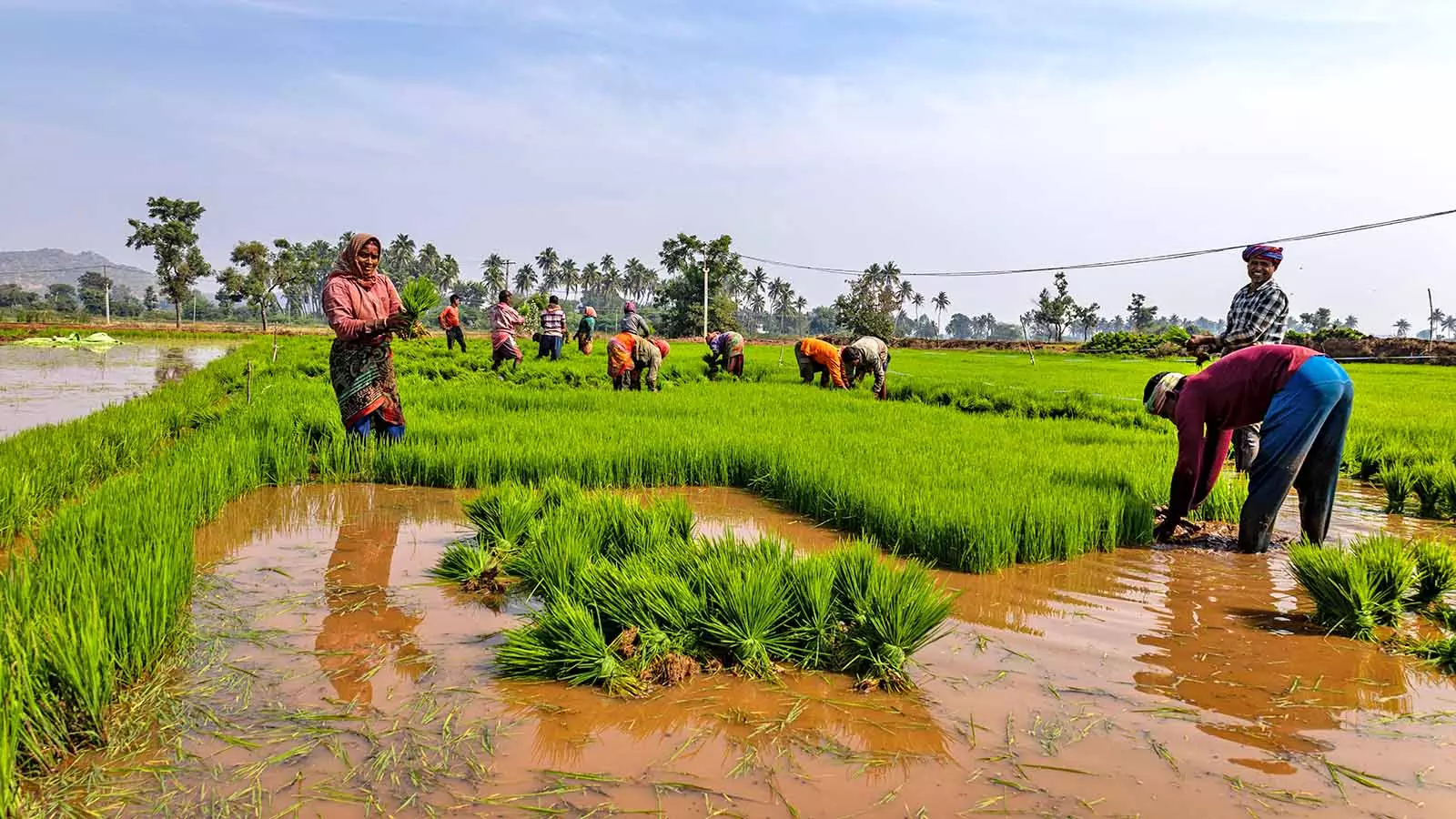
Refugees from Bangladesh transplanting paddy in BR Gunda village.
In BR Gunda village, women wearing shakha pola bangles work tirelessly in paddy fields in January. Displaced from their homes in Bangladesh decades ago and still struggling to establish themselves in their settlements in Sindhanur, these farmers are renowned for their paddy cultivation skills. Dominant caste landowners hire these refugees in hoards each season for negligible amounts and rely on their skills for steady production.
“We are brought to the fields every day from Sindhanur during sowing season because of how quickly we work. Fifteen of us can transplant an acre in an hour,” says Lakshmi (name changed) with a hint of pride. “Standing in flooded fields all day is hard work and we don’t get paid much—the men get about ₹250-300 per day, while we, women, get around ₹150-200. But it's work and we're good at it,” she adds.
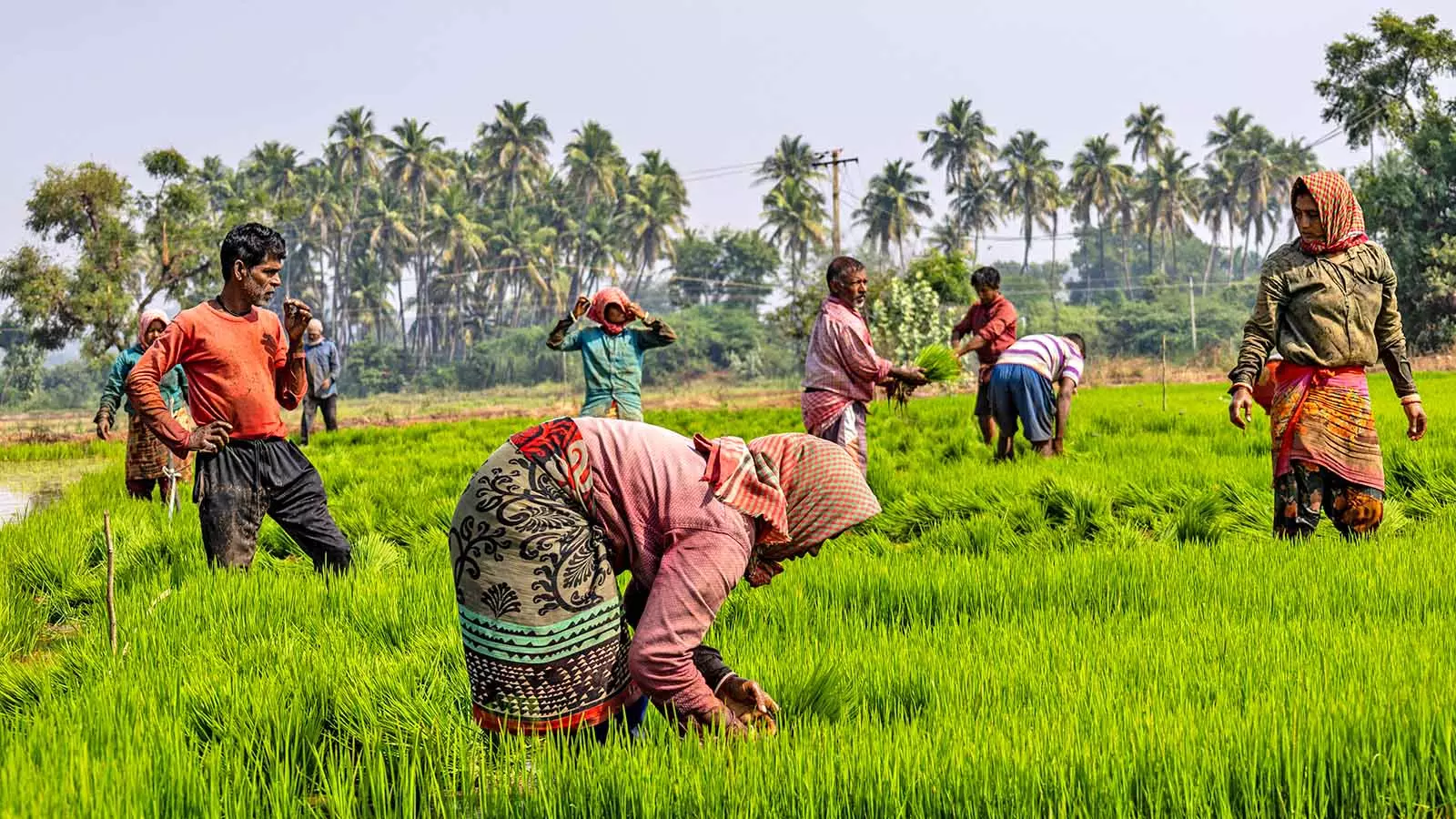
Lakshmi and the group from SIndhanur transplanting paddy in BR Gunda.
Raichur, along with Koppal and Ballari districts, is known as the ‘rice bowl of Karnataka’. This region is well-irrigated by the Krishna and Tungabhadra rivers, making it ideal for paddy cultivation. These farmers, whose battle for citizenship continues, try to make the best of the short sowing season. “We try to work in 2-3 fields every day to earn as much as possible,” says Lakshmi. While they could once depend on the harvest season for additional income, they now must compete with mechanisation as agriculture scales up.
Many wealthy farmers from the neighbouring state of Andhra Pradesh have leased or bought land in this region. They work with agricultural merchants during the harvest season to rent paddy harvesters from Hyderabad and farmers from Punjab to operate them. Recognising the efficiency of these machines, they have turned it into a business by renting the harvesters out to other farmers as well.
Now, most farmers use harvesters because it is cheaper and faster than hiring labour—local and migrant alike. It costs about ₹3,000 to harvest one acre of land using harvesters. In comparison, it costs about ₹10,000 with manual labour. The harvesters also reduce the landowners’ dependency on labour.
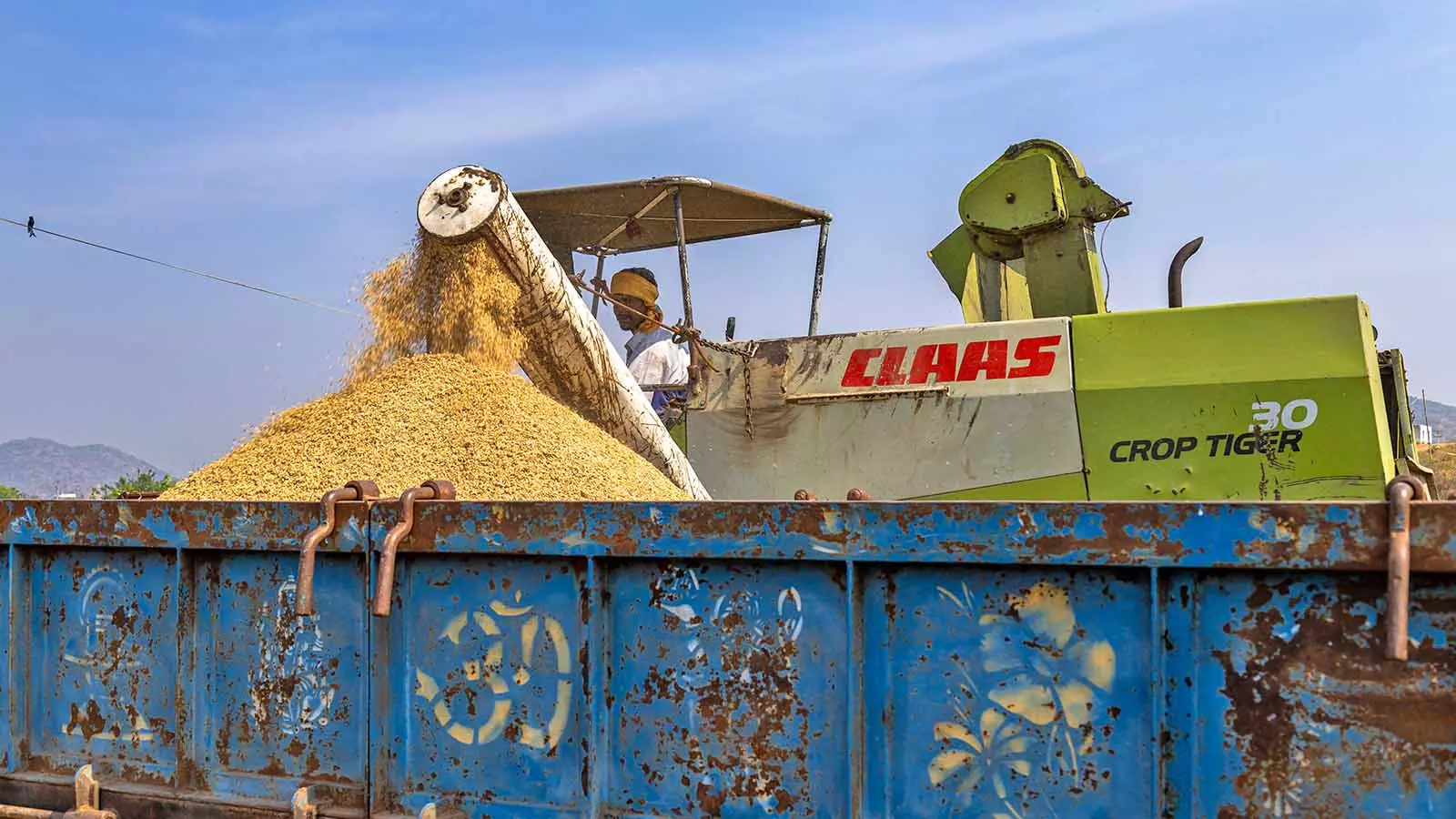
Paddy harvesting in a combined harvester.
Unlike sowing or transplanting, which is primarily done by women, harvesting is traditionally a shared task. The men cut the paddy, while the women watch over it as it sundries for 2-3 days and sort them into bags. With increasing mechanisation of agriculture, the task of operating such ‘heavy’ machines is trusted only to the men, leaving the women scrambling for income.
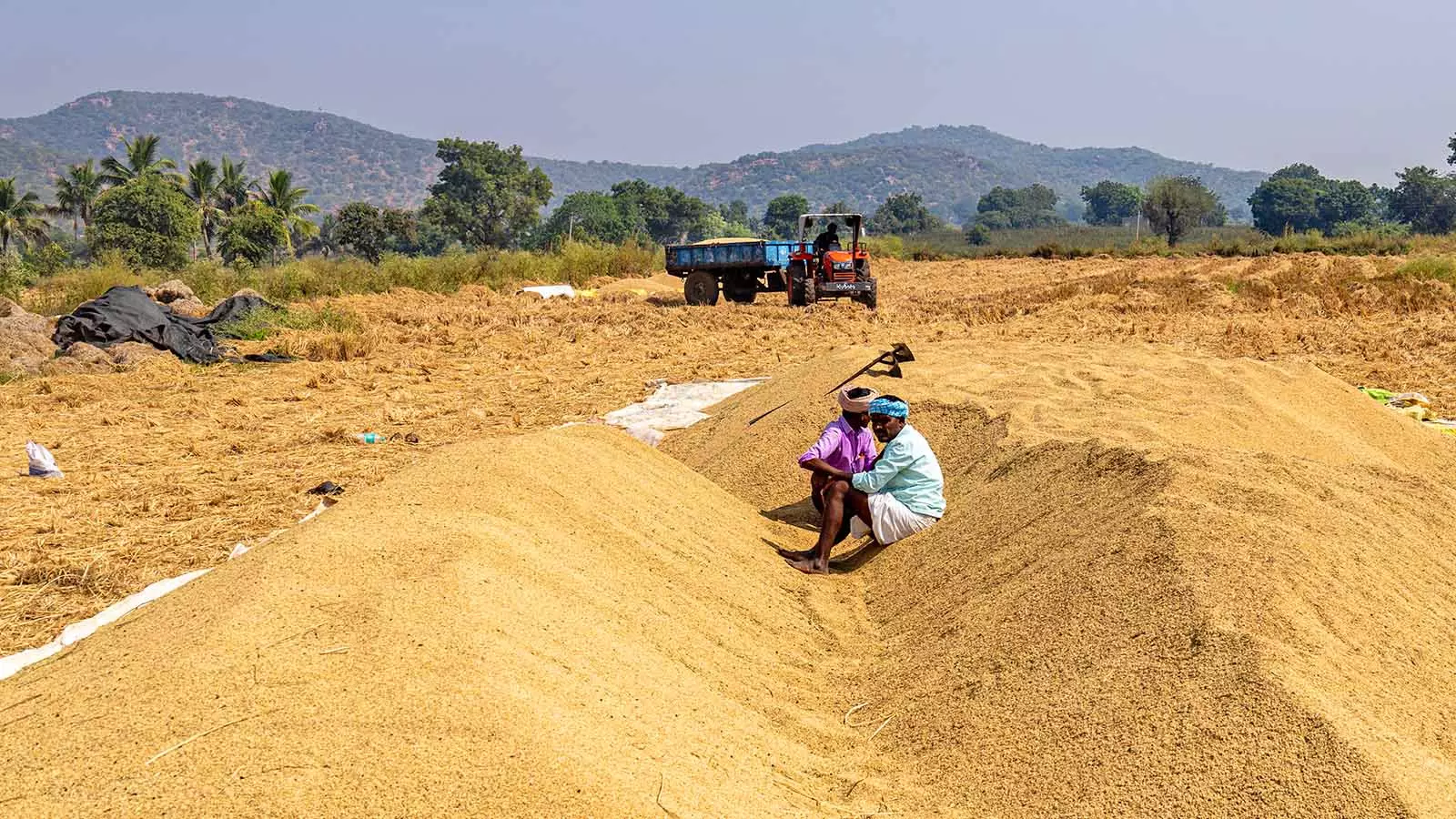
Farmers sit with harvested paddy as it dries in the sun.
Women are excluded from this innovation process in numerous ways. Aside from social hurdles, most agri-tech companies don’t design machines for women. There is also limited access to technology when it comes to the labour-intensive jobs like sowing, weeding, and transplanting. The waterlogged fields and the delicate nature of the work pose a challenge to innovators, but are those truly barriers that can’t be overcome?
The tasks that are assigned to women vary based on the crop but all of them lack technological innovation. The demanding yet delicate task of picking cotton in the black soil regions of Devadurga falls to women. They are herded to and from the fields in crowded autos or tractors as they have no other source of transport. Like with paddy, landowners have them picked up in the morning and dropped by evening. The women must work on household chores before they leave for work and after they return. “We can’t rest, whether it’s inside or outside the house,” says Kalavathi (name changed) with resignation.
Cotton is yet another kharif crop that flowers twice in a season, making it a lucrative investment. Raichur’s black soil region is a major cotton producer in Karnataka and faces similar challenges as paddy. Wealthy farmers from dominant castes own large swathes of cotton fields, and hire landless communities to work in them. The competition for jobs is intense as the season is short-lived. “We pick cotton from morning till evening and we get paid ₹8-10 per kg. We manage to earn ₹500 per day on good days,” says Lavanya, who lives in Mandalgudda village.
The precarity of their lives is evident in the grueling conditions they endure. The women are forced to limit their water intake as they have no access to sanitation facilities. Their lunches are brief and hurried, and they get no respite from the heat even as they rest. One of the women from a neighbouring village collapsed due to exhaustion and died recently. “She worked tirelessly, without even taking breaks to relieve herself or have lunch. She wasn’t feeling well but wanted to make the best of the season. Life is harsh,” says Lavanya.
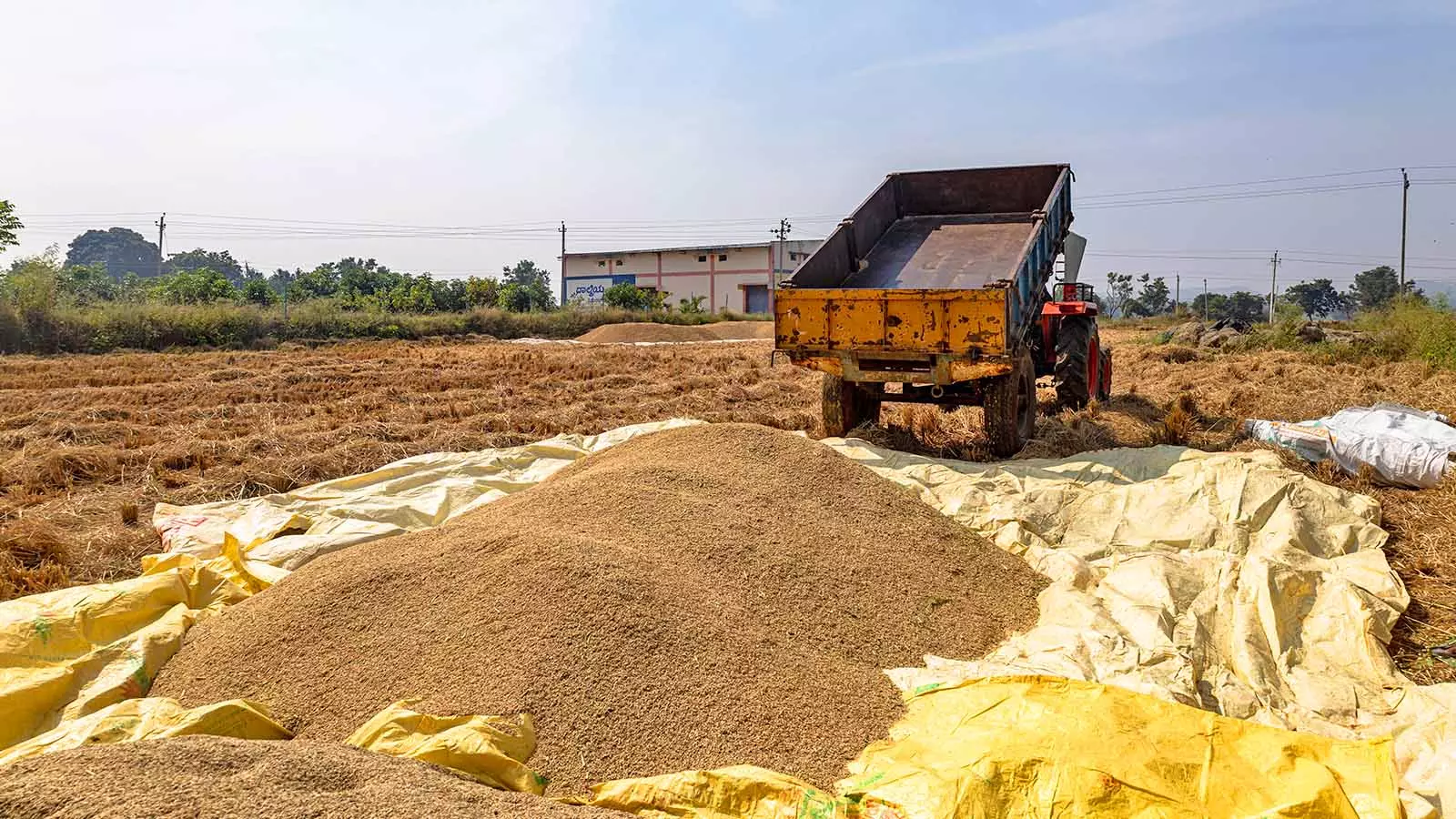
Freshly harvested paddy.
The cultivation of crops like cotton and chilli relies heavily on manual labour due to a lack of access to available machinery and a lack of machines suitable for the soil, terrain and crops grown in the region. Where efforts have been made to introduce labour-saving technologies, their adoption has been hindered by factors such as high costs.
The gendered division of labour persists across agricultural activities, with women disproportionately engaged in repetitive, labour-intensive tasks and spending more time in fields. This highlights the need to address these disparities and reduce the physical burden on women farmers.
One effective approach is to promote affordable, women-friendly machinery through subsidies, training, and collective models like custom hiring centres. Establishing and upskilling labour and women’s collectives can further enhance access to tools and alternative farming practices. This is equally important for the adoption of crop diversification, sustainable practices, improved agronomic methods, and the shift away from conventional agricultural systems. Investing in research and development, innovation, supply chain management, and operations and maintenance is a crucial part of ecosystem-building for enabling this paradigm shift.
